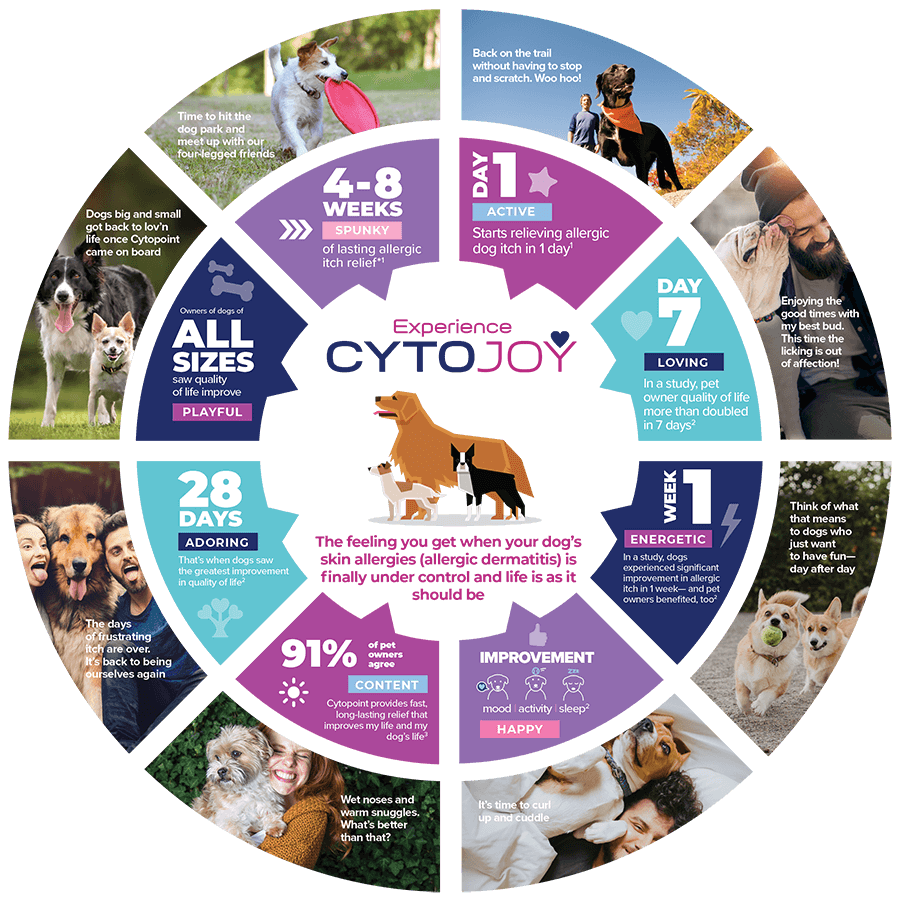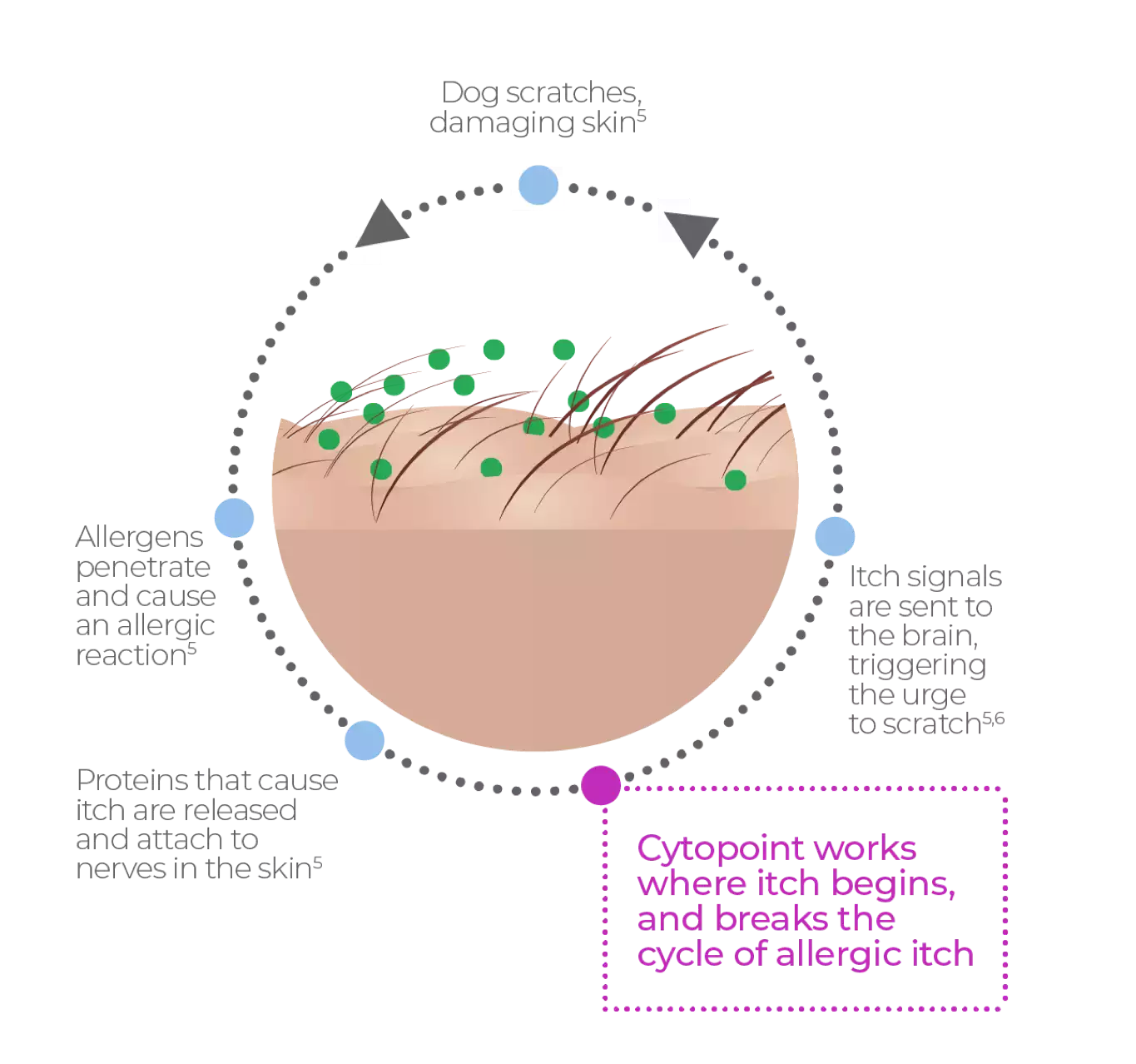
Lasting Love Deserves Lasting Itch Relief

Prescribed for over 8 million dogs and counting.1
Cytopoint® provides long-lasting itch relief for dogs with allergic dermatitis or atopic dermatitis. Ask your veterinarian how Cytopoint can provide lasting relief for your itchy dog, so everyone can get back to enjoying life’s precious moments.
Stay On Top of Your Dog’s Allergic Itch Treatments With Worry-Free Reminders

How Does Cytopoint Work?
Cytopoint works like your dog’s own immune system. It is specifically designed to target and neutralize one of the main proteins that send itch signals to your dog’s brain, which triggers scratching, licking and chewing.
- Blocks a signal that triggers allergic itch
- Relieves signs of itch such as scratching and licking2
- Allows red, irritated skin to heal2
Cytopoint is not like traditional pharmaceutical treatments for allergic itch in dogs. It is a biological medication (a protein, not a chemical) that works like your dog’s own immune system to block a main protein responsible for triggering allergic itch.3,4

Cytopoint is safe to use in dogs of any age. It can also be used in dogs on many other commonly used medications, or dogs with other diseases.7 In fact, a clinical study showed dogs receiving Cytopoint had no more side effects than dogs receiving placebo (injections without medication).7 And since Cytopoint is not a chemical-based treatment, it does not put pressure on the liver and kidneys.
With Cytopoint, you gain the comfort of knowing every injection is delivered effectively and safely during an office visit. Your veterinarian administers a complete dose that helps relieve the itch for up to 8 weeks.* Cytopoint is a great treatment option that makes it easier for you to manage your dog's allergic itch.
Allergic Itch Doesn’t Have to Interfere With Your Dog’s Life (Or Yours)
CytoJoy: the feeling you get when allergic dog itch is finally under control and life is as it should be.

Get Alerted When It’s Time for the Next Cytopoint Injection
Activate reminders and you’ll automatically receive appointment reminders by email or text.

Cytopoint Success Stories
See how Cytopoint helped dogs with allergic itch get back to enjoying life again!
Resources For You
See if your dog needs allergic itch treatment, learn about Cytopoint, track treatment progress, and set appointment reminders.
Frequently Asked Questions
Cytopoint is available at your veterinarian’s office. It is an injection that is safely delivered right in the office for comfort, convenience and peace of mind.
Just one Cytopoint injection starts controlling allergic itch within one day and provides relief that lasts for 4 to 8 weeks.*2 That means your dog may be able to go as long as 8 weeks between injections.2
Your veterinarian may schedule a progress exam 4 weeks after the first injection. Please consult your veterinarian to determine the best treatment schedule for your dog's individual needs.
Every dog is different, so monitoring your dog’s allergic itch is important. If you notice your dog is frequently scratching, licking, or chewing, you should call your veterinarian. Your veterinarian may want to adjust your dog’s Cytopoint injection schedule.
You can keep track of your dog’s allergic itch with the Cytopoint Allergic Itch Tracker. It’s simple to use and available to download here.
You never have to worry about missing an appointment, either. Activate reminders so you will know when it's time for your dog's next injection. Set up your reminders at: www.zoetispetcare.com/reminders
Yes! Cytopoint is safe to use in dogs of any age.
Cytopoint can also be used in dogs on many other medications or dogs with other diseases.7 As always, be sure to tell your veterinarian about all the medications your dog is taking.
A clinical study showed dogs receiving Cytopoint had no more side effects than dogs receiving placebo (injections without medication).7 Some of the most common side effects reported with both Cytopoint and placebo were dermatitis and bacterial skin infection.7 And since Cytopoint is not a chemical-based treatment, it does not put pressure on the liver and kidneys.
Indications: Cytopoint has been shown to be effective for the treatment of dogs against allergic dermatitis and atopic dermatitis.
*Repeat administration every 4 to 8 weeks as needed in the individual patient.2
References:
- Data on file, ZMR: GAH-284 Pets Since Launch, September 2023, Zoetis Inc.
- Data on file, Study Report No. C863R-US-12-018, Zoetis Inc.
- Gonzales AJ, Humphrey WR, Messamore JE, et al. Interleukin-31: its role in canine pruritus and naturally occurring canine atopic dermatitis. Vet Dermatol. 2013;24:48-e12. >doi:10.111/j.1365-3164.2012.01098.x.
- Olivry T, Bäumer W. Atopic itch in dogs: pharmacology and modeling. In: Cowan A, Yosipovitch G, eds. Pharmacology of Itch, Handbook of Experimental Pharmacology. 2015:357-369.
- Marsella R, Sousa CA, Gonzales AJ, et al. Current understanding of the pathophysiologic mechanisms of canine atopic dermatitis. J Am Vet Med Assoc. 2012;241(2):194-207. doi:10.2460/javma.241.2.194.
- Olivry T, DeBoer DJ, Favrot C, et al. Treatment of canine atopic dermatitis: 2010 clinical practice guidelines from the International Task Force on Canine Atopic Dermatitis. Vet Dermatol. 2010;21(3):233-248. doi:10.1111/j.1365-3164.2010.00889.x.
- Data on file, Study Report No. C961R-US-13-051, Zoetis Inc.



